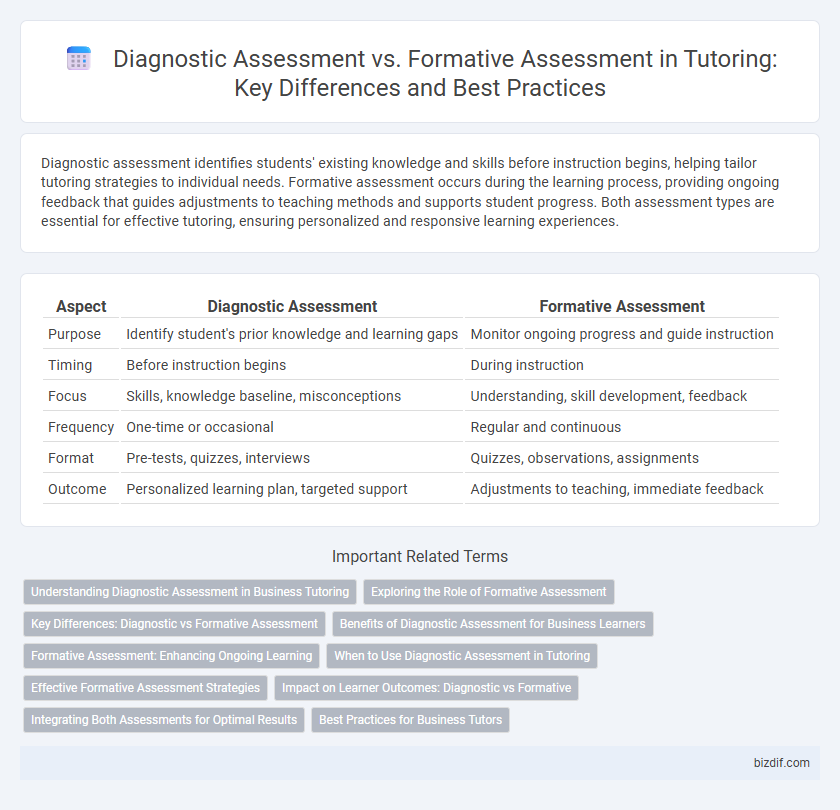Diagnostic assessment identifies students' existing knowledge and skills before instruction begins, helping tailor tutoring strategies to individual needs. Formative assessment occurs during the learning process, providing ongoing feedback that guides adjustments to teaching methods and supports student progress. Both assessment types are essential for effective tutoring, ensuring personalized and responsive learning experiences.
Table of Comparison
| Aspect | Diagnostic Assessment | Formative Assessment |
|---|---|---|
| Purpose | Identify student's prior knowledge and learning gaps | Monitor ongoing progress and guide instruction |
| Timing | Before instruction begins | During instruction |
| Focus | Skills, knowledge baseline, misconceptions | Understanding, skill development, feedback |
| Frequency | One-time or occasional | Regular and continuous |
| Format | Pre-tests, quizzes, interviews | Quizzes, observations, assignments |
| Outcome | Personalized learning plan, targeted support | Adjustments to teaching, immediate feedback |
Understanding Diagnostic Assessment in Business Tutoring
Diagnostic assessment in business tutoring identifies students' existing knowledge, skills, and learning gaps before instruction begins, enabling personalized lesson planning that targets specific weaknesses. This assessment type uses tools such as pre-tests, questionnaires, and interviews to gather detailed insights on learners' comprehension of core business concepts like finance, marketing, and management. By contrast, formative assessment monitors ongoing progress, but diagnostic assessment establishes a baseline critical for effective, customized tutoring strategies.
Exploring the Role of Formative Assessment
Formative assessment plays a critical role in tutoring by providing ongoing feedback that helps both tutors and students identify learning gaps and adjust instruction in real-time. Unlike diagnostic assessment, which evaluates prior knowledge at the start, formative assessment continuously monitors progress, enabling personalized support tailored to individual student needs. Effective use of formative assessment techniques enhances student engagement and improves academic outcomes by promoting active learning and self-regulation.
Key Differences: Diagnostic vs Formative Assessment
Diagnostic assessment identifies students' pre-existing knowledge, skills, and learning gaps before instruction begins, enabling personalized tutoring strategies. Formative assessment occurs during the learning process, providing ongoing feedback to adjust teaching methods and improve student understanding in real-time. The key difference lies in diagnostic assessment's role in initial planning versus formative assessment's focus on continuous monitoring and support.
Benefits of Diagnostic Assessment for Business Learners
Diagnostic assessment identifies specific skill gaps and knowledge deficits among business learners, enabling tailored tutoring that targets individual needs. It provides detailed insights into learners' strengths and weaknesses, facilitating more efficient use of instructional time and resources. Early identification of challenges enhances learner confidence and accelerates mastery of complex business concepts.
Formative Assessment: Enhancing Ongoing Learning
Formative assessment plays a crucial role in tutoring by continuously monitoring student progress and providing immediate feedback to enhance learning outcomes. This approach helps identify individual learning gaps during lessons, allowing tutors to tailor instruction and promote skill mastery effectively. Regular formative assessments foster an adaptive learning environment, improving student engagement and long-term retention.
When to Use Diagnostic Assessment in Tutoring
Diagnostic assessment in tutoring is essential at the beginning of an instructional period to identify students' prior knowledge, skill gaps, and learning needs. This assessment guides the customization of lesson plans and targets areas requiring remediation or enrichment. Employing diagnostic assessment early ensures more effective and personalized tutoring strategies that enhance student performance.
Effective Formative Assessment Strategies
Effective formative assessment strategies include real-time feedback, adaptive questioning, and interactive activities that continuously gauge student understanding. Utilizing diagnostic assessments at the start allows tutors to identify specific learning gaps to tailor formative techniques more precisely. Implementing techniques such as exit tickets, peer reviews, and progress tracking fosters ongoing improvement and personalized student support.
Impact on Learner Outcomes: Diagnostic vs Formative
Diagnostic assessment identifies learners' existing knowledge gaps and misconceptions before instruction, enabling tailored lesson plans that target specific weaknesses. Formative assessment continuously monitors student progress during learning, providing immediate feedback that promotes skill development and concept mastery. Together, these assessments enhance learner outcomes by ensuring personalized instruction and timely interventions that address individual needs.
Integrating Both Assessments for Optimal Results
Integrating diagnostic and formative assessments in tutoring enhances personalized learning by identifying student strengths and areas for improvement early on, while continuously monitoring progress. Diagnostic assessments establish baseline understanding, enabling tailored instruction, whereas formative assessments provide ongoing feedback that refines teaching strategies and supports mastery of content. This combined approach maximizes student engagement and achievement by creating a dynamic learning environment that adapts to individual needs.
Best Practices for Business Tutors
Diagnostic assessment identifies students' existing knowledge and learning gaps before instruction begins, enabling business tutors to tailor lesson plans effectively. Formative assessment continuously monitors student progress through quizzes, discussions, and feedback, allowing tutors to adjust teaching strategies in real-time for improved understanding. Best practices include combining both assessments to create personalized, data-driven learning experiences that enhance student engagement and mastery in business topics.
Diagnostic Assessment vs Formative Assessment Infographic

 bizdif.com
bizdif.com